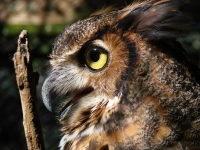 Help Us Grow!
Help Us Grow! Saving Wildlife Together - Saving the Great Horned Owl
Saving Wildlife Together - Saving the Great Horned OwlGreat Horned Owl
(go back to The Animals)
 An adaptable bird, the great horned owl lives in forests, deserts, prairies, farmland, and low mountain areas throughout most of North and South America. A nighttime hunter, these owls prey on rodents and other small mammals, birds, invertebrates, fish, and reptiles. The powerful talons of the great horned owl allow them to kill and carry animals several times heavier than themselves. Sound deadening filaments at the tips of the owl’s flight feathers, which permit noiseless flight, plus the wide field of vision and acute hearing make this owl ideal for night hunting. The great horned owl usually has two to three eggs in an abandoned large twig-and-stick nesting site, the cavity of a tree, shallow hole in the ground, or in a farm building. The young, called owlets, leave the nest after about six weeks but do not fly well until nine to ten weeks old. Although the great horned owl is not endangered, it may lose its prey as a result of habitat destruction.
An adaptable bird, the great horned owl lives in forests, deserts, prairies, farmland, and low mountain areas throughout most of North and South America. A nighttime hunter, these owls prey on rodents and other small mammals, birds, invertebrates, fish, and reptiles. The powerful talons of the great horned owl allow them to kill and carry animals several times heavier than themselves. Sound deadening filaments at the tips of the owl’s flight feathers, which permit noiseless flight, plus the wide field of vision and acute hearing make this owl ideal for night hunting. The great horned owl usually has two to three eggs in an abandoned large twig-and-stick nesting site, the cavity of a tree, shallow hole in the ground, or in a farm building. The young, called owlets, leave the nest after about six weeks but do not fly well until nine to ten weeks old. Although the great horned owl is not endangered, it may lose its prey as a result of habitat destruction.
Great Horned Owl - Fast Facts
Type: BirdDiet: Carnivore
Average lifespan in the wild: 5 to 15 years
Size: Body, 18 to 25 in (46 to 63 cm); Wingspan, 3.3 to 4.8 ft (1 to 1.5 m)
Weight: 2 to 5.5 lbs (1 to 2.5 kg)
Did you know? Though the female great horned owl is larger than the male, his call is much lower.
Status: STABLE
Buy an Eye and help save the Great Horned Owl.


 Help
Help





 Check this out...
Check this out...
 Your Account
Your Account